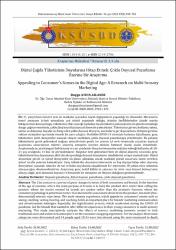Dijital çağda tüketicinin duyularına hitap etmek: çoklu duyusal pazarlama üzerine bir araştırma
Abstract
21. yüzyıl hem tüketici hem de markalar açısından büyük değişimlerin yaşandığı bir dönemdir. Markaların
temel amacının ürünü satmaktan çok ürünü yaşatmak olduğu, ürünün özelliklerinden ziyade marka
hikâyelerinin konuşulduğu, tüketicinin elde edeceği faydadan ziyade tüketici psikolojisinin ön planda tutulduğu
duygu çağının temelinde, çoklu (beş boyutlu) duyusal deneyim yatmaktadır. Tüketicinin görme, koklama, tatma,
işitme ve dokunma duyularına hitap eden çoklu duyusal deneyim, markaların gerek pazarlama iletişimi gerekse
reklam stratejileri içerisinde önemli bir yere sahiptir. Özellikle COVID-19 süreciyle hızlanan dijitalleşme, genç
tüketicilere farklı deneyimler sunmak isteyen markaları, çoklu duyusal pazarlamaya yöneltmiştir. Bu çalışma
tüketicilerin gerek geleneksel mağaza atmosferinde gerek ise çevrim içi web ortamında yaratılan duyusal
pazarlama unsurlarının tüketici alışveriş deneyimi üzerine etkisini betimsel olarak analiz etmektedir.
Araştırmada üç ana kategori belirlenmiş ve yarı yapılandırılmış derinlemesine mülakat tekniği kullanılarak 18-
24 yaş aralığında 14 kişi ile görüşülmüştür. Bulgular hem geleneksel hem de dijital alışveriş sırasında genç
tüketicilerin beş duyusunun aktif olarak uyarıldığı duyusal deneyimler istediklerini ortaya koymaktadır. Dijital
alışverişte görsel ve işitsel deneyimler ön plana çıkmakta, ancak markalar görsel unsurlara önem verirken
işitsel tarafta yetersiz kalmaktadır. Genç tüketiciler duyuların internetini ve beş duyuya hitap eden alışveriş
deneyimini yaşamak isteseler de tat ve koku duyularına ulaşabilecek bir internetin 10 yıldan önce mümkün
olmayacağını düşünmektedirler. Araştırma, genç hedef kitlelerin yalnızca bir ürün veya hizmet bulma/satın
almaya değil, aynı zamanda duyusal ve benzersiz bir deneyime de ihtiyacı olduğunu göstermektedir. The 21st century is a period of great changes in terms of both consumers and brands. In the baseline
of the age of emotion, where the main purpose of brands is to keep the product alive rather than selling the
product; where the stories created by brands are spoken rather than the product’s features; where the
consumer psychology is prioritized rather than the benefits consumers obtain from the product, lies multi (five-
dimensional) sensory experience. The multi-sensory experience, which appeals to consumers’ senses such as
seeing, smelling, tasting, hearing, and touching, holds an important place for brands’ marketing communication
and advertisement strategies. Especially, the digitalization process, which accelerated during the COVID-19
pandemic, led the brands that wanted to offer different experiences to their young consumers to multi-sensory
marketing. This study descriptively analyzes the effects of sensory marketing elements created in both
traditional store and online web atmosphere on the consumer shopping experience. For the analysis three main
categories were determined and 14 people aged 18-24 were interviewed using the semi-structured in-depth interview technique. Findings reveal that during both traditional and digital shopping, young consumers want
to undergo the multi-sensory experience in which their five senses are actively stimulated. Visual and auditory
experiences come to the fore in digital shopping; but they think brands give importance to visual elements while
being insufficient in audio studies. Although young consumers desire to experience the “Internet of the Senses”
and the shopping experience that appeals to the five senses, they think that there will be no internet that can
access the senses of taste and smell in 10 years. Research shows that young target audiences for brands need
not only find/buy a product or service, but also a sensory and unique experience.


















